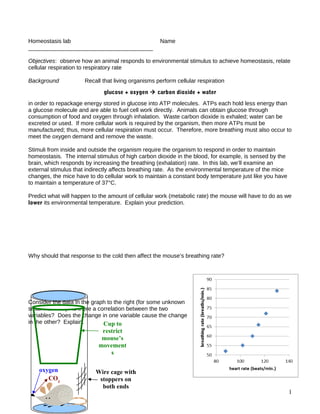
1 mouse homeostasis lab
- 1. Homeostasis lab Name _______________________________________ Objectives: observe how an animal responds to environmental stimulus to achieve homeostasis, relate cellular respiration to respiratory rate Background Recall that living organisms perform cellular respiration glucose + oxygen carbon dioxide + water in order to repackage energy stored in glucose into ATP molecules. ATPs each hold less energy than a glucose molecule and are able to fuel cell work directly. Animals can obtain glucose through consumption of food and oxygen through inhalation. Waste carbon dioxide is exhaled; water can be excreted or used. If more cellular work is required by the organism, then more ATPs must be manufactured; thus, more cellular respiration must occur. Therefore, more breathing must also occur to meet the oxygen demand and remove the waste. Stimuli from inside and outside the organism require the organism to respond in order to maintain homeostasis. The internal stimulus of high carbon dioxide in the blood, for example, is sensed by the brain, which responds by increasing the breathing (exhalation) rate. In this lab, we’ll examine an external stimulus that indirectly affects breathing rate. As the environmental temperature of the mice changes, the mice have to do cellular work to maintain a constant body temperature just like you have to maintain a temperature of 37°C. Predict what will happen to the amount of cellular work (metabolic rate) the mouse will have to do as we lower its environmental temperature. Explain your prediction. Why should that response to the cold then affect the mouse’s breathing rate? Consider the data in the graph to the right (for some unknown small mammal). Is there a correlation between the two variables? Does the change in one variable cause the change in the other? Explain. Cup to restrict mouse’s movement s oxygen Wire cage with CO2 stoppers on both ends 1
- 2. Method There are two types of chambers we will use: wire cages and plastic environmental chambers. You will find some plastic chambers already immersed in ice in the lab – please do not remove them. We only move the wire cages. You will also find mice in wire cages – there is no need for you to handle the mice (they bite and poop!). Be sure there is a little plastic cup in the wire cage to restrict the movement of the mouse, but don’t squish the mouse. Also be sure the end caps are on both ends of the wire cage tightly. First, put your mouse’s cage inside the plastic chamber at room temperature. Let him adjust for about 5 min. Meanwhile, change the experiment time on the computer to 700 seconds by clicking Experiment, then Data Collection, then change the time to 700 s. As soon as you seal the mouse’s chamber with the stopper, press the data collection button on the computer to record the amount of oxygen in the chamber. Collect data for 10 minutes – the software measures this time in seconds (s). Ignore the readings for the first 100 s; the mouse is adjusting to its new environment. Note the % O2 at 100 s. Describe the trend in the data, recording the initial (100 s) O2 and final (700 s) O2 amounts (recorded as % O2 in the air). Record your data (don’t forget temperature) in the data table. Second, put your mouse’s cage inside the plastic chamber in the ice chest. Let the mouse acclimate for a couple of minutes – no longer than 5. As soon as you seal the chamber with the stopper, press the data collection button on the computer to record the amount of oxygen in the chamber. Collect data for 10 minutes. Ignore the first 100 s again; the mouse is adjusting to its new environment. Note the % O2 at 100 s and the temperature at 700 s. Remove the mouse’s cage from the ice. Describe the trend in the data, recording the starting (at 100 s) O2, final (at 700 s) O2, and temperature at 700 s. Record your data in the data table. Data Temperature °C % O2 at Final % O2 % O2 Briefly 100 s % O2 at decreased decreased describe the 700 s in 10 min. in 1 min. trend room temp. mice on ice! 2
- 3. Oxygen and temperature sensors sending results to computer Cup to restrict mouse’s movement s oxygen Wire cage with CO2 stoppers on both ends Plastic chamber with stopper and O2 sensors on open end Before leaving lab, be sure that your results are comparable to those of the other students in lab. Are there large discrepancies? If so, what might explain them? Postlab – Be sure to use the GROUP data posted on Bb, not your own data Do the data support your prediction on p. 1? Explain briefly. Why did the mice respond to colder temperatures the way they did? Explain in terms of breathing rate and cellular respiration rate. 3
- 4. Did the mice exhibit negative or positive feedback to maintain homeostasis? Explain. What do you think would happen if we had increased the temperature above room temperature? Explain. Why does the presence of the mouse reduce the % of O2 in the air in the chamber? What is replacing the O2? Why? You noted differences between your data and others’ data in lab. What is a source of natural variation in the data? Explain. What is a source of experimental variation in the data? Explain. 4